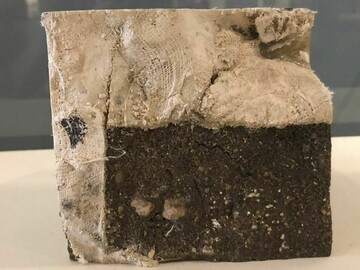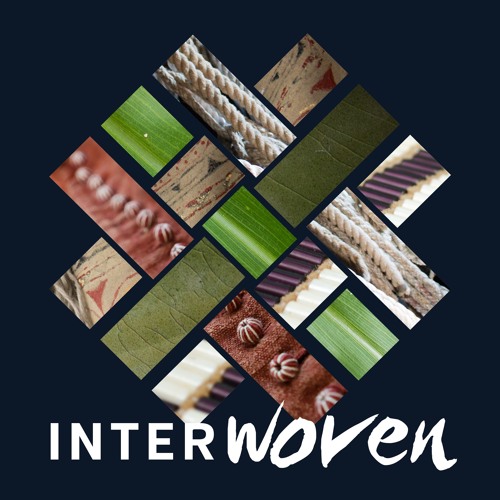Corn Planting Mound (Soil Micromorphology Block)
- Date
- c.1600-1700/Excavated 2016
- Material
- Sediment with herring bones
- Author/Maker
- Maker’s name is no longer known. Excavated by the University of Massachusetts Boston Fiske Center for Archaeological Research.
- Source
- University of Massachusetts Boston Fiske Center for Archaeological Research

This image is provided courtesy of the University of Massachusetts Boston Fiske Center for Archaeological Research
Description
For generations, Wampanoag women fertilized their fields with fish such as Blueback herring (Alosa aestivalis) and Alewife herring (Alosa pseudoharengus). Wampanoag historian Nanepashemet has characterized this practice not as a rule, but rather “a strategy developed for coping with poor soil conditions when the luxury of fallow fields did not exist.”1Guided by Tisquantum, early English colonists adopted the practice. In 1621, Edward Winslow reported the year’s successful harvest to a friend in England:
We set the last spring some twenty acres of Indian corn, and sowed some six acres of Barley & Peas, and according to the manner of the Indians, we manured our ground with Herrings or rather Shads, which we have in great abundance, and take with great ease at our doors. Our Corn did prove well, & God be praised, we had a good increase of Indian corn, and our Barley indifferent good, but our peas not worth the gathering.2
A generation later, the practice of using fish as fertilizer continued. In 1662, the royal governor of Connecticut, John Winthrop Jr., wrote to the newly-formed Royal Society of London for Improving Natural Knowledge (known today as the Royal Society):
Where the Ground is not very good, or has been long planted and worn out, the Indians used to put two or three of those forementioned Fishes under each place upon which they planted their Corn, or if they had not time before planting, then they would put them afterwards into the Earth by the sides of those Corn hills, and by these means had far greater crops then that ground would otherwise produce, many times more then double, the English have learned this good husbandry of the Indians.3
Herring are anadromous, meaning that they migrate annually from salt to freshwater to spawn and lay their eggs. Today, visitors to Patuxet (Plymouth) still watch tens of thousands of herring migrate or “run” up the brook each spring. In the Wampanoag calendar, this annual event marks the coming of spring and the beginning of a new year, celebrated with social gatherings and celebrations. Wampanoag scholars’ and culture keepers’ collaboration with archaeologists demonstrates that the practice of fertilizing with herring has been carried out by Native people for generations.
Media

Archaeologist and Museum Gardener, Dr. Fred Dunford, discusses with Interwoven host Hilary Goodnow the transformation of Indigenous and English agricultural practices and the role archaeology plays in helping us better understand farming and gardening from different historic and cultural perspectives.
This episode was made possible in part by the National Endowment for the Humanities. Any views, findings, conclusions, or recommendations in this podcast do not necessarily represent those of the National Endowment for the Humanities.
Plymouth 2016 Burial Hill Site
View PDFTranscription
Plymouth 2016, Burial Hill Site, EU17, CXT 265, Hand Sample 6
Highlighting bone fragments at the base of possible corn planting feature
Visible light
Longwave UV
Auto-fluorescence
Width of each view is 30mm
Discussion Questions
- What do Wampanoag people add to the soil to help their gardens grow? Can you find an example in this artifact?
-
How did the English colonists use traditional Wampanoag knowledge to improve their harvest?
-
Compare the planting mound with Governor William Bradford’s written description of Tisquantum’s teaching the English to plant corn. How do the two primary sources support each other?
-
Did the English colonists’ first harvest succeed? How do you know?
-
How can oral history and traditional knowledge work with archaeology and written documents to help us understand the past?
-
Why is it important to recognize the contributions of Indigenous people?
Footnotes
- 1 Nanepashamet, “It Smells Fishy To Me: An Argument Supporting the Use of Fish Fertilizer by the Native People of Southern New England,” Dublin Seminar for New England Folklife. 1991. pg. 15
- 2 EW, “A Letter sent to a friend in these parts.” Mourt’s Relation:A Journal of the Pilgrims at Plymouth ed. Dwight Heath (Bedford, MA: Applewood Books, 1963), 81-82
- 3 Fulmer Mood,”John Winthrop Jr. On Indian Corn” New England Quarterly Vol.X No. 1 (March 1937), pg. 128